AMD Athlon 64 4000+ & FX-55: A Thorough Investigation
by Anand Lal Shimpi on October 19, 2004 1:04 AM EST- Posted in
- CPUs
Multitasking Content Creation
MCC Winstone 2004
Multimedia Content Creation Winstone 2004 tests the following applications in various usage scenarios:
. Adobe® Photoshop® 7.0.1
. Adobe® Premiere® 6.50
. Macromedia® Director MX 9.0
. Macromedia® Dreamweaver MX 6.1
. Microsoft® Windows MediaTM Encoder 9 Version 9.00.00.2980
. NewTek's LightWave® 3D 7.5b
. SteinbergTM WaveLabTM 4.0f
As you can see above, Lightwave is part of the MCC Winstone 2004 benchmark suite. As an individual application, Lightwave does manage to get a healthy performance benefit with multithreaded rendering enabled, especially when paired with Hyperthreading enabled CPUs like the Pentium 4s here today. The latest MCC Winstone patch allows for a selection of how many threads to launch during the Lightwave test, the options range from 1 - 8 threads.
Based on our tests it seems as if 4 threads yields the highest performance on the Pentium 4 platform, and thus we used that setting for all of our tests. The Athlon 64s perform identically with 1 or 4 threads as they are not multithreading capable processors, so the AMD scores did not change.
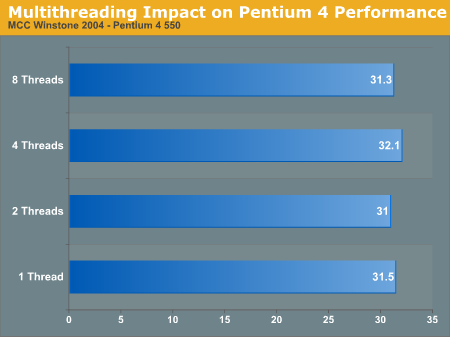
Despite the inclusion of Hyperthreading support, MCC Winstone 2004 still shows AMD performing much better in an area where Intel once dominated. While the Prescott based Pentium 4 560 is at the front of the Intel pack, it is still outperformed by the Athlon 64 3400+.
Here the single vs. dual channel memory gap shrinks to under 3% when we compare the 3400 and 3800+ processors, but also worth noting that the added cache of the 4000+ is also only responsible for about a 2% performance gain. Put the two together and you've got a decent combination in the Athlon 64 4000+, but separately the features don't bring much to the table to justify the added cost.
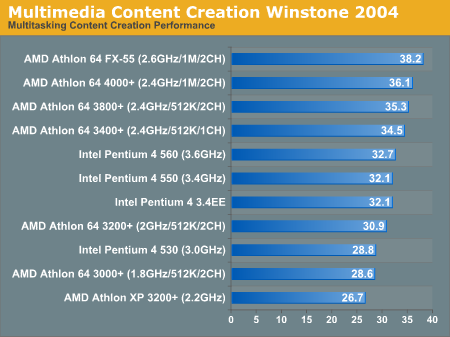
ICC SYSMark 2004
The first category that we will deal with is 3D Content Creation. The tests that make up this benchmark are described below:
"The user renders a 3D model to a bitmap using 3ds max 5.1, while preparing web pages in Dreamweaver MX. Then the user renders a 3D animation in a vector graphics format."
Intel has historically done very well under SYSMark 2004, especially when it comes to Internet Content Creation applications. Here we've got a number of very NetBurst friendly applications running at the same time and the results aren't too surprising.
For once we have the Pentium 4 560 out on top, distancing itself from the Athlon 64 FX-55 by almost 5%. The Prescott core flexes its muscle as the longer pipeline does it no harm, with the Pentium 4 550 performing on level ground with the Northwood based 3.4EE.
The three 2.4GHz AMD chips settle in the middle of the pack, followed by the Pentium 4 530 and the remaining Athlon 64s and Athlon XP. 3D rendering continues to be a strongpoint for the Pentium 4, with the combination of 3D rendering and animation giving Intel the much needed lead here.
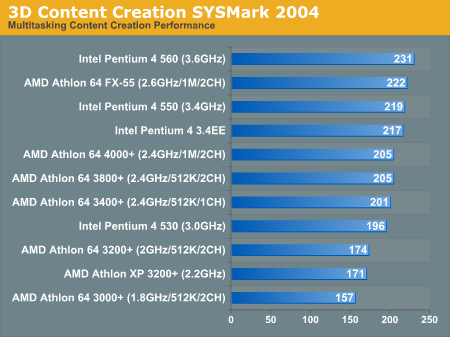
Next, we have 2D Content Creation performance:
"The user uses Premiere 6.5 to create a movie from several raw input movie cuts and sound cuts and starts exporting it. While waiting on this operation, the user imports the rendered image into Photoshop 7.01, modifies it and saves the results. Once the movie is assembled, the user edits it and creates special effects using After Effects 5.5."
The race is much closer in the 2D Content Creation test, with the Pentium 4 560 virtually tied for the lead with AMD's Athlon 64 FX-55.
Once again we see no difference between the 512KB L2 3800+ and the new 4000+ armed with a 1MB L2 cache. There continues, however, to be a slight performance impact when going down to the single channel Athlon 64 3400+.
Looking at the Athlon XP we see just how important the Athlon 64 has been
to AMD, without it we'd be analyzing another Intel dominated test.
Here's another situation where Prescott seems to be breaking even when
it comes to performance. Remember that Prescott's lengthened pipeline should
penalize it significantly, but thanks to Prescott's other core optimizations
and larger cache it manages to perform just as well as the Northwood based
Extreme Edition here.
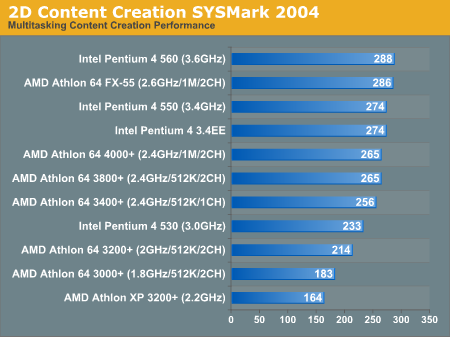
The Internet Content Creation suite is rounded up with a Web Publishing performance test:
"The user extracts content from an archive using WinZip 8.1. Meanwhile, he uses Flash MX to open the exported 3D vector graphics file. He modifies it by including other pictures and optimizes it for faster animation. The final movie with the special effects is then compressed using Windows Media Encoder 9 series in a format that can be broadcast over broadband Internet. The web site is given the final touches in Dreamweaver MX and the system is scanned by VirusScan 7.0."
The situation remains mostly unchanged in SYSMark's final Internet Content Creation test. The Pentium 4 560 heads up the pack, followed very closely by the Athlon 64 FX-55 as well as the Pentium 4 550 and 3.4EE.
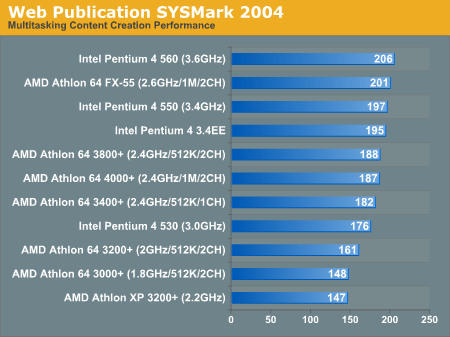
Mozilla + Media Encoder
While AMD dominated in WorldBench 5's Mozilla test, encoding a file using Windows Media Encoder in the background not only makes this test more appreciative of the Pentium 4 but also of Hyper Threading.
Despite the seemingly perfect Hyper Threading scenario, it doesn't help Intel win the lead here. The Athlon 64 FX-55 and the 4000+ manage to win here, followed by the 3.4EE. Without any spatial locality between the two very different applications being run enabling Hyper Threading essentially gives each one of the applications half of the cache they would have running solo, thus giving the 3.4EE an advantage over the Pentium 4 560.
We also see that the cache advantage is clearly present on the AMD side as well, with the 4000+ enjoying a 6.7% advantage over the 3800+, with the only difference between the chips being an additional 512KB of L2 cache.
The rest of the results are no surprise given the leaders, the Athlon 64 continues to be quite strong here.
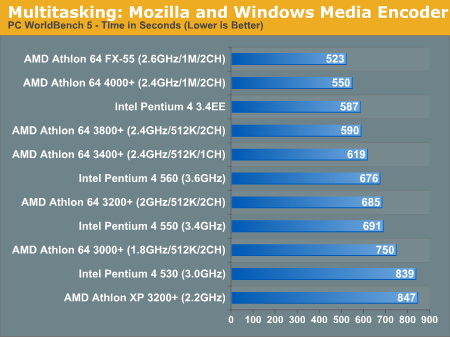










89 Comments
View All Comments
val - Wednesday, October 20, 2004 - link
for me is AMD unacceptable until there are good chipsets. All i have ever seen or had in my computers was big garbage with permanent problems and mysterious difficulties.Even SIS chipsets looks much better for intel than SIS for AMD. Its not anymore about CPU, CPU are fast for many tasks and that few percent of price or performance makes no deal, but overall quality talks strongly for Intel.
Save your time AMD fanboys to reply me something like that your AMD platform runs perfect and you had problems with intel and so on, its cheap and cannot anyway motivate me for change.
And yes, i have 2 AMD and 2 Intel computers and many i had or seen before (at home, work, school, projects, customers).
Gnoad - Wednesday, October 20, 2004 - link
3GHZ! Wow, I already was an AMD fan, but that just totally blows me away. Crazy stuff.GoHAnSoN - Tuesday, October 19, 2004 - link
nice article. Thxcoldpower27 - Tuesday, October 19, 2004 - link
Very nice, I await the day AMD releases a 3GHZ Athlon 64. These processor are niced but priced in a range where volumes are rather low, they have nice bragging rights though :PDa DvD - Tuesday, October 19, 2004 - link
3GHz on air :SAMD's really out of trouble for the coming year(s)
I can imagine K8@90nm scaling well beyond 3GHz...
(lol, or even top Prescott clockspeeds? That would be insane..)
Wesley Fink - Tuesday, October 19, 2004 - link
#30 and #43 -Once AMD informed us that strained silicon was used in the FX55 I couldn't resist a bit of a run with overclocking the FX55. The nForce4 Reference boad is not really intended or designed for overclocking, since it doesn't have any CPU or memory voltage adjustments. However it does support a wide range of multipliers so I could try a few settinngs.
I had no probelm at all running at 14.5X or 2.9GHz at default voltage. At that speed I ran quite a few benchmarks and a Quake 3 of 604.2 FPS. The FX55 actually booted at 3.0GHz but it never made it through a stable XP boot. I suspect with just a bit of CPU voltage 3.0GHz would be possible with the FX55 on air. All cooling was just the new AMD stock fan which now includes copper fins and heat pipes.
verybusy - Tuesday, October 19, 2004 - link
There is some FX55 and 4000+ overclocking info at http://www.hothardware.com/viewarticle.cfm?page=2&...Assuming that my request from above is granted regarding other overclocking of 3500+, 3200+ and 3000+, I'd like to see just how overclocking turns out with the retail heatsink and fan. I hope that's not too much of a request.
Thanks...
verybusy - Tuesday, October 19, 2004 - link
I liked the review of the Athlon 64 4000+ and FX-55 and it was nice to see it compared to the other Athlon 64 3200+ and 3000+ processors running at stock speeds.Unfortulately, with this review following so closely behind the 3500+ and 3000+ review (.09 Athlon 64: Value, Speed and Overclocking), it would have been very useful to see the 3500+, 3200+ and 3000+ overclocked to 2.6GHz as well. Afterall, the .09 3500+/3000+ @290x9 is faster than the FX53 (2.4GHz-1MB) err I mean Athlon 64 4000+). The overclocked 3500+, 3200+ and 3000+ could be pretty much as quick as the FX55 couldn't it?
That's what I want to see anyway.
ViRGE - Tuesday, October 19, 2004 - link
#39, Anand mentions that it's multiplier locked.Zebo - Tuesday, October 19, 2004 - link
Guys the 3400 newcastle is a way underated chip. It should have been, by all rights, called a 3600. I guess they did'nt want the 3500 to look bad agains a "old" 754 newcastle though.As for the review, total AMD performance domination at low relative speeds temps and power consumption.:) Youd have to be a fool to buy intels netburst crap right now.